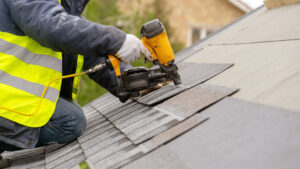Flat Roof Coating North Carolina is a great way to extend the life of a flat roof and protect it from the elements. It’s also a much more cost-efficient alternative to replacing the roof entirely.

One of the main benefits of a flat roof coating is that it is reflective, which can help to lower energy costs by keeping the building cooler and reducing the amount of air conditioning needed.
Flat roof coatings are becoming an increasingly popular roofing alternative. These roof coatings seal the roof and prevent leaks, and they also reflect sunlight, which can cut down on energy expenditures. In addition, many roof coatings can be used with different types of roofing systems, including tile, asphalt shingles, and metal. However, the type of roof that a building owner has will affect the long-term performance of the flat roof coating. Some roof coatings are liquid-applied, while others are applied by spraying. Regardless of the type of roof that is being coated, it is important to consult a professional roofing company in order to choose the right product for the job.
A properly-applied flat roof coating can extend the lifespan of the roof and reduce repair costs. It can also improve a commercial building’s energy efficiency. This is because flat roof coatings can reduce the amount of heat that enters a building, which helps to lower energy costs.
Liquid roof coatings can be applied to virtually any type of flat or low-sloped roofing system. They are typically made from silicone or urethane. They are also water-ready, which means that they can withstand standing water for extended periods of time. This is a significant benefit since many flat roofs contain ponding water in certain areas, especially around drains and scuppers.
The reflective surface of a flat roof coating can significantly reduce the amount of heat that enters he building. This, in turn, lowers energy bills and cuts down on carbon emissions. This can help a building owner stay in compliance with local environmental regulations and can even boost its Energy Star rating. A properly-applied flat roof coating can be a wise investment for any commercial building owner.
Protection from the Elements
Flat roofs take a lot of abuse from the elements, and they are prone to water and impact damage. A flat roof coating acts as a protective barrier against the elements and helps stave off damage to your roofing materials, saving you money and headaches down the road.
When applied by a professional, roof coatings provide solid protection for a flat roof. They also protect the roof’s structural integrity and contribute to energy efficiency by reflecting sunlight, which can lower air conditioning costs. Additionally, the smooth and tight appearance of a coated roof makes it easier to spot and repair any damage or leaks.
A commercial building’s roof takes more of a beating than most people realize. From the sun’s harsh UV rays to fluctuating temperatures and intense storms, there is much that can go wrong with your roof membrane over time. Eventually, seams and other details will start to fail, leaving you with leaks that could lead to costly repairs.
A flat roof coating protects against weather and water damage by sealing cracks, seams, and gaps. It also adds an attractive aesthetic to your roof, making it look newer and more appealing. Additionally, a well-sealed and protected flat roof can increase the lifespan of your roofing materials.
One of the most popular flat roof coatings is silicone. Silicone is known for its durability, sustainability, and aesthetically pleasing appearance. Silicone is able to withstand ponding water permanently, and it can also be used on metal, modified bitumen, single-ply, EPDM, and built-up roofs. However, silicone is not highly resistant to abrasion, and it can be slippery in wet conditions. It is best suited for low-traffic areas.
Longevity
A flat roof coating can increase the lifespan of your roof. This is because it protects your flat roof against moisture damage and other structural problems that would otherwise shorten the life of your flat roof. In addition to extending your flat roof’s lifespan, a coating can also help you save money on expensive roofing materials and labor.
The longevity of your flat roof depends on a number of factors, including the type of roofing material and maintenance practices. However, in general, a well-constructed and maintained flat roof can last for up to 30 years.
To extend the life of your flat roof, it is important to conduct regular inspections and repairs. Look for early signs of significant damage, such as visible leaking or rot, and promptly address them to avoid more costly repair costs down the road. In addition, you should perform routine cleanings and ensure that proper drainage is occurring.
The permeability of your flat roof is another factor that can influence its lifespan. Typically, elastomeric roof coatings have low perm ratings and are highly effective at blocking moisture transmission. This helps to prevent moisture build-up on the flat roof, which can cause extensive structural damage and lead to costly repairs.
Regardless of the roofing material you have on your flat roof, it’s always a good idea to consider coating it. Whether you have an asphalt-based rolled roof or a rubber-based single-ply roof, a flat roof coating can significantly improve its longevity. The best part is that a flat roof coating is relatively inexpensive compared to other roof restoration options. This makes it a cost-effective option for homeowners and business owners alike.
Easy Maintenance
Flat roof coatings are a relatively inexpensive way to extend the life of your commercial flat roof. While they can’t fix any serious structural damage that has already occurred to the roof, they can protect your roofing system from the elements and prevent further damage, extending its lifespan by decades.
One of the most significant benefits offered by flat roof coatings is improved energy efficiency. The coatings are reflective, which keeps the building cooler and can significantly reduce air conditioning costs. They also seal leaks and keep outside air from entering the building, lowering heating costs as well.
The reflective properties of the flat roof coatings can also help protect the roofing material from the sun’s UV rays. These rays can accelerate deterioration of the roofing materials, leading to cracks and leaks over time. A coating with UV resistance and reflectivity can greatly extend the lifespan of a roof.
Leaks are among the most common issues that can arise with a flat roof, and these can be expensive to repair or replace. A flat roof coating can provide a watertight seal to the roof, keeping moisture and debris out of the structure. This can significantly cut down on the need for costly repairs or replacements.
When it comes to selecting the best flat roof coating, you should consult with a professional roofing company and read product reviews. Be sure to consider your building’s unique needs, climate and budget when making a decision. For example, some coatings are rated and warranted for ponding water, while others are not. You may also want to consider a coating that can be easily repaired in case of minor leaks or other problems.
Environmentally Friendly
In addition to being environmentally friendly, flat roof coatings are a cost-effective alternative to complete roof replacement. Coatings can protect the underlying materials from damage, improve energy efficiency and reduce cooling costs, and help prolong the life of the flat roofing system.
Waterproofing is an important benefit of flat roof coatings, as they provide a seal that prevents leaks and other structural problems. They also make it easier to spot and repair any issues with the roof.
The benefits of roof coatings extend beyond waterproofing, however. They can help save on energy costs by reflecting the sun’s rays, which can decrease the amount of air conditioning needed in a building.
When choosing a flat roof coating, it is essential to find one that is compatible with the underlying material of the roofing system. Silicone, for example, is a great option for many types of flat roofing systems, including metal, single-ply, built up, EPDM rubber, and sprayed polyurethane foam. It is durable, chip-resistant, and resists the formation of mold. In addition, silicone is “non-sacrificial,” meaning it does not deteriorate and expose the substrate to additional damage from UV radiation over time.
Another benefit of silicone is that it will not pond water like other flat roof coatings. Ponding water, especially on older flat roofs, can lead to structural damage and encourage the growth of things like moss. In addition, if the flat roof is not structurally sound and cannot be corrected with the installation of roof drains or repitching, silicone can still be applied to areas that are prone to ponding. The chemistry of silicone also means it will not chalk or degrade over time, making it a long-term solution for any type of flat roof.

